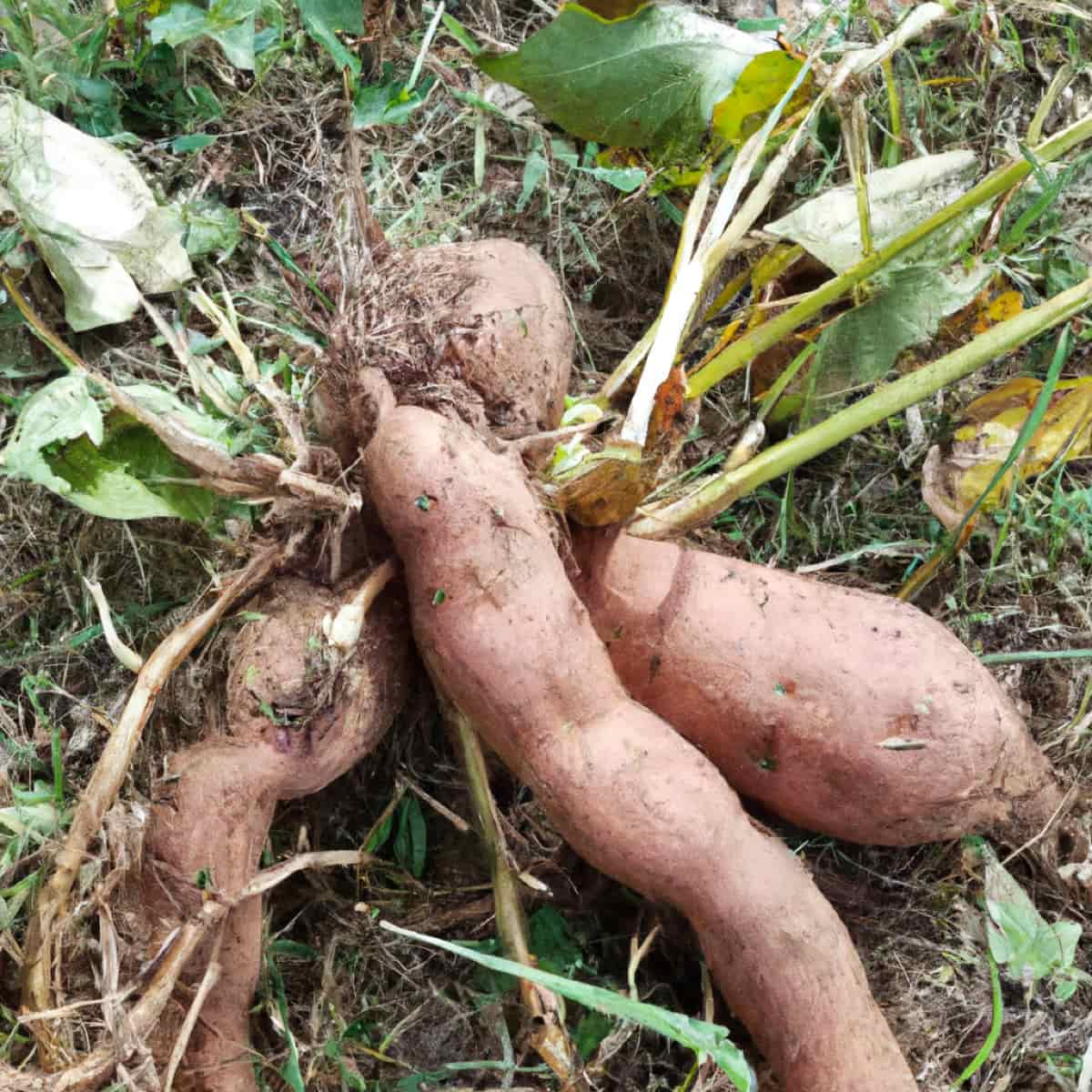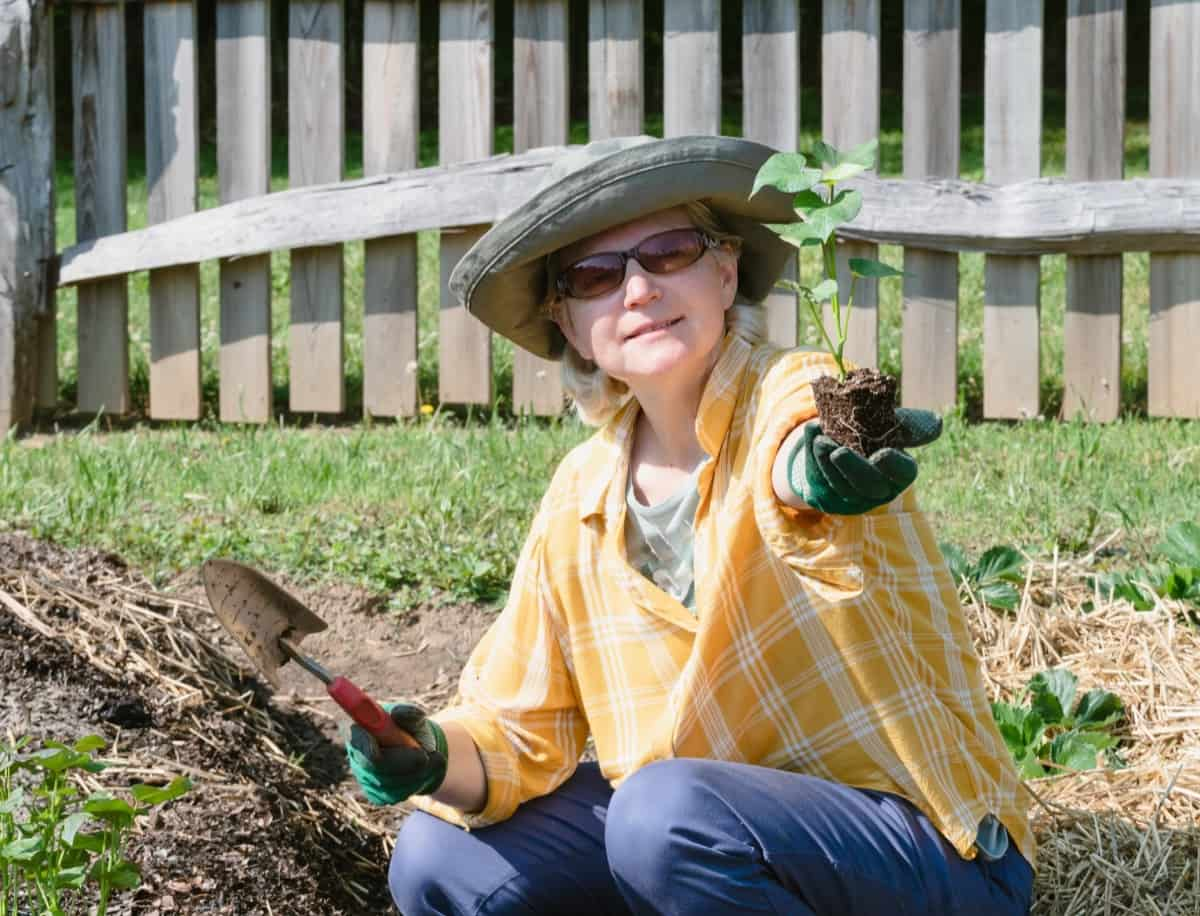A verdant backyard often serves as a wonderful sanctuary, especially when it becomes a source of homegrown, nutritious food. Growing Sweet Potatoes at Home, right in your backyard, is an excellent venture to consider, especially when you appreciate this versatile vegetable’s health benefits and taste.

Sweet potatoes can be grown from store-bought ones, in the soil, in containers such as buckets or bags, and even from sweet potato slips or vines. This article will comprehensively guide Backyard Sweet Potatoes: Growing From Scratch for Planting to Harvesting. We’ll also delve into how long sweet potato takes to grow and the various stages of sweet potato growth.
Step-by-step Guide for Growing Backyard Sweet Potatoes
The journey of Growing Sweet Potatoes From Sweet Potatoes begins with selecting a sweet potato. Choose a healthy, organic one and cut it in half. Place each half in a jar of water, half submerged, using toothpicks to keep it balanced. Sprouts, known as slips, will grow within a week or two. When they are four to five inches long, gently twist them off and place them in a jar of water where they will develop roots. Once these roots are an inch long, these slips are ready to be planted.
Growing Sweet Potatoes in the Soil involves a well-draining, sandy, and slightly acidic soil. Dig a trench about six inches deep, placing the slips about a foot apart and covering them, exposing the top leaves.
Tips and Tricks for Successful Sweet Potato Cultivation in Your Backyard
To enhance your success, remember that growing sweet potatoes prefer warm conditions. Planting should be undertaken after the risk of frost has subsided and when the soil temperature reaches a minimum of 60 degrees Fahrenheit. Growing Sweet Potatoes in Containers such as buckets or bags is also a viable option. This is particularly helpful if you have limited backyard space or poor soil. Ensure the containers have good drainage and are filled with compost and potting soil.
Best Practices for Growing Sweet Potatoes at Home
Sweet potato plants love the sun, so plant them in an area where they’ll get full sun exposure. It’s essential to keep the soil consistently moist but not waterlogged as they grow. Excessive water can result in the development of root rot. Implement a regular watering schedule to maintain consistent soil moisture.
Essential Requirements for Cultivating Sweet Potatoes in Your Backyard
One requirement for Growing Sweet Potatoes Slips is warmth. As tropical plants, sweet potatoes need full sun and warm temperatures. Additionally, they require a long growing season of at least four months of warm weather. Another requirement is nutrient-rich soil. Before planting, enrich your soil with aged compost or a balanced organic fertilizer.
Choosing the Right Variety of Sweet Potatoes for Backyard Cultivation
There are numerous sweet potato varieties with unique growth habits and tastes. ‘Beauregard’ is among the most popular, known for its great yield and disease resistance. ‘Centennial’ is also well-loved, particularly for those who enjoy a classic sweet potato flavor. Experiment with different varieties to find what suits your palate and climate best.
In case you missed it: Project Report of 1-Acre Sweet Potato Farming: Production Economics, Cultivation Cost, and Profit

Preparing the Soil for Successful Sweet Potato Growth in Your Backyard
Start by loosening the soil to about a foot deep and then mix in a 2- to 4-inch layer of compost. This will improve the soil’s fertility and drainage. Sweet potatoes thrive in well-draining, sandy soil, so consider adding sand if your soil is clay-like.
Watering and Fertilizing Techniques for Backyard Sweet Potato Cultivation
Regular watering is crucial during the first few weeks after planting. Once established, sweet potatoes can handle some dry spells. However, for the best harvest, keep the soil consistently moist. An ideal fertilizer for effective fertilization consists of low nitrogen content and high levels of phosphorus and potassium. Apply an organic, slow-release fertilizer at planting time.
Protecting Sweet Potato Plants From Pests and Diseases in Your Backyard
Common pests include sweet potato weevils, wireworms, and beetles. Control these pests by maintaining clean surroundings and rotating your crops yearly. Proper irrigation techniques and crop rotation can prevent fungal diseases such as black rot and wilt. If the disease does occur, use an appropriate organic fungicide and remove affected plants.
Harvesting and Storing Homegrown Sweet Potatoes From Your Backyard
Knowing the stages of Sweet Potato Growth is vital for the best harvesting time. Generally, sweet potatoes are ready to harvest when the leaves start to yellow, usually about 3-4 months after planting. To harvest, gently dig around the plants and lift the tubers out.
Don’t wash them but let them dry and cure in a warm, humid place for about 10 days. This process allows the skin to harden and sweet flavors to develop. Storing these homegrown sweet potatoes involves placing them in a cool, dark, and well-ventilated area. Avoid storing them in the fridge as it’s too cold and can alter their taste.
Common Mistakes to Avoid When Growing Sweet Potatoes in Your Backyard
Overwatering is a common mistake in Growing Sweet Potatoes in Buckets or any other containers. This can lead to root rot. Another common error is not considering the length of your growing season. Sweet potatoes require a long growing season. So, if you live in a colder climate, you’ll need to start your plants indoors or use black plastic to warm the soil before planting.
Monitoring Sweet Potato Plant Growth in Your Backyard
Once you have successfully planted your sweet potato slips, the key is to regularly monitor your plants. Observe your sweet potato vines as they will demonstrate the health of your plants. Ideally, the vines should be lush and spread out across the ground. If the vines appear to be wilting or are discolored, it may indicate an issue with pests, disease, or watering.
Growing sweet potatoes require patience as the tubers take their time to grow and develop. The stages of sweet potato growth are vital to keep track of as they mature. You can gently dig around the topsoil near the plant base to check on their progress. If the potatoes are small and underdeveloped, cover them with soil and wait a bit longer before checking again.
In case you missed it: 7 Common Problems with Sweet Potato Plants: Treatment and Solutions

Conclusion
In summary, cultivating sweet potatoes in your backyard, be it in the soil, containers, or even from store-bought ones, is not only possible but also an incredibly rewarding experience. These versatile tubers, with their vibrant vines, not only enhance the aesthetics of your garden but also provide a healthy, nutritious food source.
By sticking to the tips and best practices outlined in this guide, from choosing the right variety to understanding the stages of sweet potato growth, you’re well on your way to a successful harvest. This venture serves as a testament to the potential of our backyards – they can indeed be transformed into a thriving, food-producing space. So here’s to the joy and satisfaction of growing sweet potatoes at home and the delightful dishes they will inspire in your kitchen.
- Ultimate Guide to Ossabaw Island Hog: Breeding, Raising, Diet, and Care
- Ultimate Guide to Juliana Pig: Raising Facts, Size, Diet, Care, and Lifespan
- Raising Lleyn Sheep: Disadvantages, Price, Uses, Characteristics, and Care
- Ultimate Guide to Meishan Pig: Breed Facts, Breeding, Raising, and Care
- Ultimate Guide to Teacup Pigs: Raising, Diet, Lifespan, Cost, and Care
- Guide to Raising Poll Dorset Sheep: Facts, Profile, Characteristics, Uses, and Care
- Ultimate Guide to Bighorn Sheep: Characteristics, Diet, Lifespan, Breeding, and Lifecycle
- Ultimate Guide to Raising Katahdin Sheep: Farming Facts, Breed Profile, Uses, and Care
- Ultimate Guide to Raising Oreo Cows: Belted Galloways Farming Facts, Profile, Uses, and Care